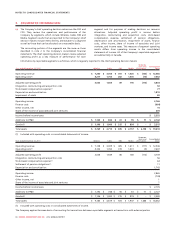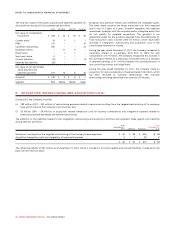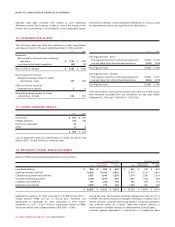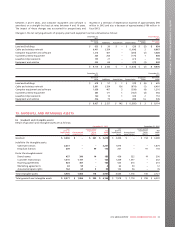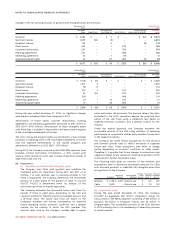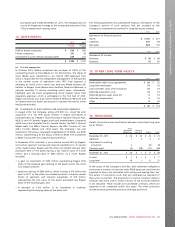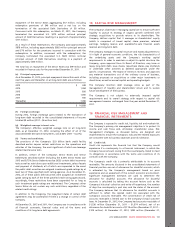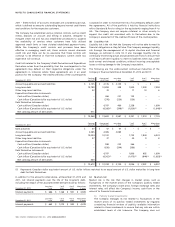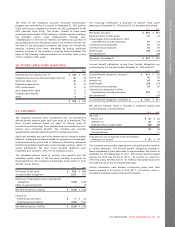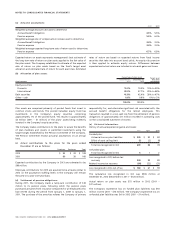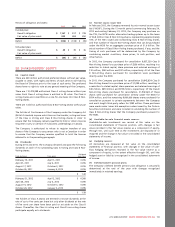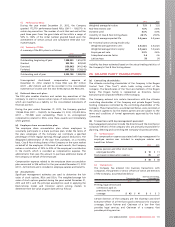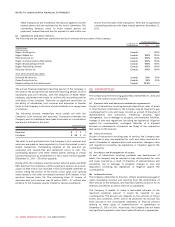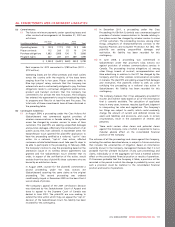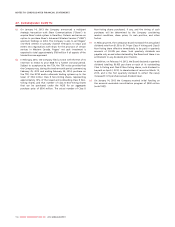Rogers 2012 Annual Report Download - page 108
Download and view the complete annual report
Please find page 108 of the 2012 Rogers annual report below. You can navigate through the pages in the report by either clicking on the pages listed below, or by using the keyword search tool below to find specific information within the annual report.
NOTES TO CONSOLIDATED FINANCIAL STATEMENTS
2011 – $478 million) of accounts receivable are considered past due,
which is defined as amounts outstanding beyond normal credit terms
and conditions for the respective customers.
The Company has established various internal controls, such as credit
checks, deposits on account and billing in advance, designed to
mitigate credit risk and has also established procedures to suspend
the availability of services when customers have fully utilized
approved credit limits or have violated established payment terms.
While the Company’s credit controls and processes have been
effective in managing credit risk, these controls cannot eliminate
credit risk and there can be no assurance that these controls will
continue to be effective or that the Company’s current credit loss
experience will continue.
Credit risk related to the Company’s Debt Derivatives and Expenditure
Derivatives arises from the possibility that the counterparties to the
agreements may default on their respective obligations under the
agreements in instances where these agreements are in an asset
position for the Company. The creditworthiness of the counterparties
is assessed in order to minimize the risk of counterparty default under
the agreements. All of the portfolio is held by financial institutions
with a Standard & Poor’s rating (or the equivalent) ranging from A- to
AA-. The Company does not require collateral or other security to
support the credit risk associated with its Derivatives due to the
Company’s assessment of the creditworthiness of the counterparties.
(b) Liquidity risk:
Liquidity risk is the risk that the Company will not be able to meet its
financial obligations as they fall due. The Company manages liquidity
risk through the management of its capital structure and financial
leverage, as outlined in note 18. It also manages liquidity risk by
continually monitoring actual and projected cash flows to ensure that
it will have sufficient liquidity to meet its liabilities when due, under
both normal and stressed conditions, without incurring unacceptable
losses or risking damage to the Company’s reputation.
The following are the undiscounted contractual maturities of the
Company’s financial liabilities at December 31, 2012 and 2011:
December 31, 2012 Carrying
amount Contractual
cash flows Less than
1 year 1to3
years 4to5
years More than
5 years
Accounts payable and accrued liabilities $ 2,135 $ 2,135 $ 2,135 $ – $ – $ –
Long-term debt 10,789 10,858 348 1,920 1,500 7,090
Other long-term liabilities 33 33 – 17 10 6
Expenditure Derivative instruments:
Cash outflow (Canadian dollar) – 366 231 135 – –
Cash inflow (Canadian dollar equivalent of U.S. dollar) – (378) (239) (139) – –
Debt Derivative instruments:
Cash outflow (Canadian dollar) – 4,797 460 2,338 – 1,999
Cash inflow (Canadian dollar equivalent of U.S. dollar) – (4,208)(1) (348)(1) (1,920)(1) – (1,940)(1)
Net carrying amount of derivatives 511
$ 13,468 $ 13,603 $ 2,587 $ 2,351 $ 1,510 $ 7,155
December 31, 2011 Carrying
amount Contractual
cash flows Less than
1 year 1to3
years 4to5
years More than
5 years
Bank advances $ 57 $ 57 $ 57 $ – $ – $ –
Accounts payable and accrued liabilities 2,085 2,085 2,085 – – –
Long-term debt 10,034 10,102 – 1,725 1,844 6,533
Other long-term liabilities 37 37 – 20 9 8
Expenditure Derivative instruments:
Cash outflow (Canadian dollar) – 598 232 366 – –
Cash inflow (Canadian dollar equivalent of U.S. dollar) – (630) (244) (386) – –
Debt Derivative instruments:
Cash outflow (Canadian dollar) – 4,797 – 1,806 992 1,999
Cash inflow (Canadian dollar equivalent of U.S. dollar) – (4,302)(1) – (1,475)(1) (844)(1) (1,983)(1)
Net carrying amount of derivatives 460
$ 12,673 $ 12,744 $ 2,130 $ 2,056 $ 2,001 $ 6,557
(1) Represents Canadian dollar equivalent amount of U.S. dollar inflows matched to an equal amount of U.S. dollar maturities in long-term
debt for Debt Derivatives.
In addition to the amounts noted above, at December 31, 2012 and
2011, net interest payments over the life of the long-term debt,
including the impact of the associated Debt Derivatives are as follows:
December 31, 2012 Less than
1 year 1to3
years 4to5
years More than
5 years
Interest payments $ 686 $ 1,168 $ 901 $ 3,929
December 31, 2011 Less than
1 year 1to3
years 4to5
years More than
5 years
Interest payments $ 663 $ 1,219 $ 920 $ 4,229
(c) Market risk:
Market risk is the risk that changes in market prices, such as
fluctuations in the market prices of the Company’s publicly traded
investments, the Company’s share price, foreign exchange rates and
interest rates, will affect the Company’s income, cash flows or the
value of its financial instruments.
(i) Publicly traded investments:
The Company manages its risk related to fluctuations in the
market prices of its publicly traded investments by regularly
conducting financial reviews of publicly available information
related to these investments to ensure that any risks are within
established levels of risk tolerance. The Company does not
104 ROGERS COMMUNICATIONS INC. 2012 ANNUAL REPORT


